Recipes
Ham and Cheese Muffins: Savory Snacks for Babies and Toddlers!
Awaken your little one's taste buds with these delicious ham and cheese muffins – perfect for snacking adventures!

Hey there, parent extraordinaire! Whip up these ham and cheese muffins for your tiny tots, packed with calcium, protein, and essential nutrients. Substitute eggs with bananas or tofu, and don't forget the spinach for an extra health kick. Pop them in the fridge for snacking bliss for up to 5 days, or freeze for later munching! Bake at 180°C for 25 minutes, and voilà – savory goodness awaits. Want to take these muffins to the next level? Stay tuned for more pro tips on how to spice up this toddler-friendly treat!
Key Takeaways
- Incorporate egg replacements like mashed bananas or tofu for baby-friendly muffins.
- Use cheddar cheese and ham for calcium and iron benefits.
- Store muffins in the fridge for up to 5 days or freeze for longer shelf life.
- Reheat muffins in the microwave for a quick snack option for babies and toddlers.
- Serve muffins as a standalone snack or pair with a side salad for a balanced meal.
Description
Ham and cheese muffins for babies and toddlers are savory and nutritious snacks that are easy to prepare. These cheese savory muffins aren't only delicious but also packed with protein, calcium, and essential nutrients that are crucial for your little one's growth and development.
Whether it's for breakfast, snack time, or packed in their lunchboxes, these muffins are a versatile option that your child will love.
One of the best things about these ham and cheese muffins is that you can make them ahead of time and freeze them for later. This makes them a convenient choice for busy days or when you need a quick snack on the go.
Plus, these muffins are a sneaky way to incorporate some veggies into your picky eater's diet without them even noticing.
Ingredients
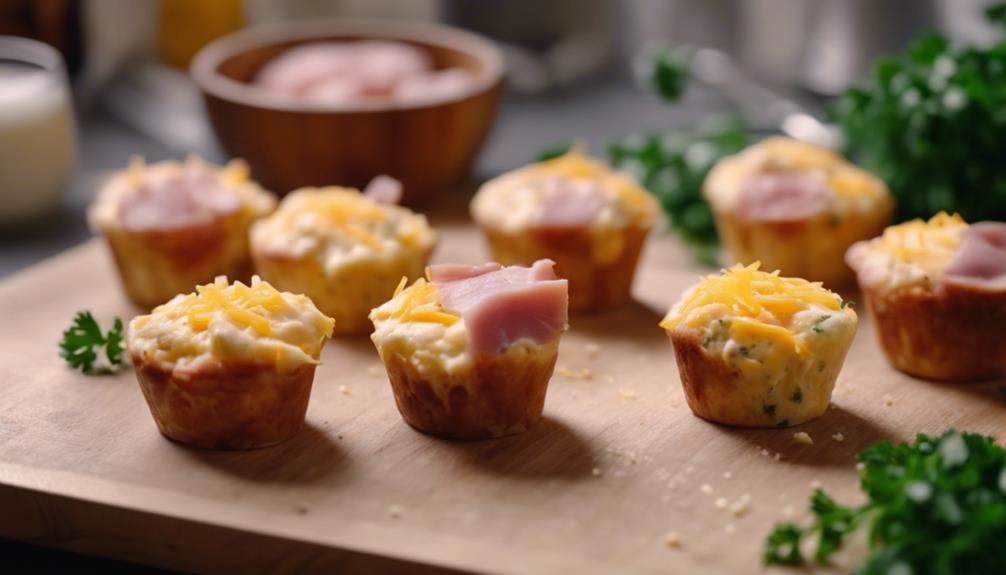
When it comes to making ham and cheese muffins for your little ones, exploring ingredient substitutions, understanding the nutritional benefits, and mastering storage and serving tips are crucial points to keep in mind.
Making small tweaks to the ingredients can cater to different dietary needs or preferences, while also keeping things interesting for your young eaters.
Knowing how to store and serve these muffins guarantees that they remain fresh and delicious for your little food critics to enjoy.
Ingredient Substitutions
Consider incorporating egg replacements like mashed bananas, tofu, or ground flaxseeds when making ham and cheese muffins for babies and toddlers. These substitutes not only cater to various tastes and dietary needs but also provide binding and moisture similar to eggs, ensuring delicious muffins without eggs. Check out the table below for a quick comparison of these egg replacements:
| Egg Replacement | Benefits |
|---|---|
| Mashed Bananas | Adds natural sweetness and moisture to the muffins, making them a hit with little ones. |
| Tofu | Offers a protein boost and a fluffy texture to the muffins, perfect for a more substantial snack. |
| Ground Flaxseeds | Rich in omega-3 fatty acids and fiber, enhancing the nutritional value of the muffins. |
Experimenting with these egg substitutes allows you to customize the recipe to suit specific dietary requirements and preferences, ensuring that every bite is both tasty and nutritious for your little munchkins.
Nutritional Benefits
To understand the nutritional benefits of the ingredients used in the ham and cheese muffins for babies and toddlers, let's take a closer look at the key components.
Cheddar cheese in these muffins provides calcium and protein, important for bone health and growth in little ones.
The ham brings iron and vitamins to the table, supporting healthy red blood cell production and overall immunity.
Spinach, another star ingredient, adds fiber, antioxidants, and vitamins A and C, which promote digestive health and boost the immune system.
Eggs, a powerhouse of high-quality protein, essential amino acids, and choline aid in brain development for growing children.
Lastly, milk in the mix supplies calcium, vitamin D, and healthy fats, all essential for strong bones, teeth, and overall growth in infants and toddlers.
With these nutritional benefits packed into these savory muffins, you can feel good about offering a tasty and nourishing snack to your little ones.
Storage and Serving
To keep your ham and cheese muffins fresh, store them in an airtight container in the fridge for up to 5 days. When it comes to longer storage, freezing the muffins in airtight containers or freezer bags is your best bet; they can last up to 3 months in the freezer. Remember to defrost frozen muffins in the fridge overnight before serving to maintain their delightful texture and taste. For a quick and convenient snack or lunch option, simply reheat the muffins in the microwave.
- Store ham and cheese muffins in the fridge for up to 5 days.
- Freeze muffins for longer storage up to 3 months.
- Defrost frozen muffins in the fridge overnight.
- Reheat muffins in the microwave for a quick snack.
These savory treats are versatile; serve them as a standalone snack or pair them with a side salad for a more filling meal. Enjoy the cheesy goodness of these muffins whenever hunger strikes!
Instructions

When it comes to making these delicious ham and cheese muffins, the baking instructions are simple to follow.
You'll need to preheat the oven, whisk your ingredients, and carefully mix everything together.
The cooking method is straightforward, ensuring your muffins turn out golden and perfectly cooked for your little ones to enjoy.
Baking Instructions
Preheat your oven to 180°C fan and get your muffin cases ready for baking.
Here are some essential baking instructions to guarantee your ham and cheese muffins turn out perfect:
- Prepare the Muffin Tray: Line a muffin tray with paper cases to prevent sticking and make cleaning up a breeze.
- Mix Wet Ingredients: Whisk together eggs, milk, and melted butter in a mixing bowl until smooth and well combined.
- Incorporate Dry Ingredients: Add grated cheese, chopped ham, oregano, and grated carrot to the wet mixture, gently folding everything together.
- Bake to Perfection: Divide the muffin batter evenly into the prepared cases, pop them in the oven, and bake for approximately 25 minutes until they're golden brown and delicious.
Follow these straightforward steps, and soon you'll be enjoying delightful ham and cheese muffins that are perfect for your little ones or as a tasty snack for yourself.
Cooking Method
Begin by whisking together eggs, milk, and melted butter in a mixing bowl for the base of your ham and cheese muffins. This delicious mixture will serve as the foundation for your savory treats.
Next, add grated cheese, chopped ham, oregano, and a hint of grated carrot to the bowl. These ingredients will infuse your ham and cheese muffins with flavor and goodness.
Don't forget to incorporate self-raising flour gradually, ensuring it blends well with the other components to form a perfect muffin batter.
Once your batter is ready, divide it evenly into 12 muffin cases. Preheat your oven to 180°C fan and place the muffin cases inside. Allow them to bake for approximately 25 minutes until they turn a beautiful golden hue and are cooked through.
The aroma filling your kitchen will be irresistible, and the taste of these ham and cheese muffins will surely delight your little ones. Enjoy the process and the delicious outcome!
Related Recipes

Discover a selection of tasty and creative recipes that complement the Ham and Cheese Muffins for Babies and Toddlers. If you enjoyed the cheesy goodness of the Ham and Cheese Muffins, here are some related recipes that you and your little ones might love:
- Macaroni Cheese Lunchbox Muffins: These kid-friendly muffins combine the comfort of macaroni and cheese in a convenient and portable form, perfect for lunchtime.
- Spinach & Cheese Savoury Lunchbox Muffins: Adding a nutritious twist to traditional muffins, these savory treats sneak in some greens alongside the cheesy goodness.
- Leftover Mashed Potato, Ham & Cheese Muffins: A creative way to repurpose leftovers, these muffins are a delicious blend of mashed potatoes, ham, and cheese.
- Ham & Cheese Roll Ups: For a fun and portable snack on busy days, these roll-ups provide a tasty combination of ham and cheese in a convenient form.
Explore these lunchbox-friendly recipes to add variety to your meal planning and keep your little ones satisfied and happy!
Comments

Let's chat about the POINTS related to the Ham and Cheese Muffins recipe.
User Engagement Strategies will help you connect with fellow parents trying out this delicious treat.
Recipe Modification Options can add a personal touch to cater to your little one's taste buds.
And don't forget to check out Recipe Storage Tips to make sure you always have a batch ready for those hungry moments!
User Engagement Strategies
Consider inviting your readers to actively participate by sharing their feedback, questions, and modifications in the comments section below the recipe. Engaging with your audience can create a sense of community and provide valuable insights into how the recipe is being received.
Here are some user engagement strategies to foster interaction:
- Encourage users to share their favorite cheese variations for these muffins.
- Prompt readers to ask about different types of ham that can be used in the recipe.
- Respond to comments promptly to show appreciation for their input and to keep the conversation going.
- Invite users to share their tips on making these muffins more appealing to babies and toddlers.
Recipe Modification Options
To enhance the versatility of the ham and cheese muffin recipe, feel free to suggest your creative modifications in the comments section below. Whether you want to add some extra veggies for a pop of color and added nutrition, swap out ingredients to make it gluten-free, dairy-free, or egg-free for dietary restrictions, or adjust the seasoning to suit your taste buds, the possibilities for modification are boundless.
You can even play around with the texture by changing up the cooking time or experimenting with different cooking methods.
Share your experiences with modifying the recipe and let others know about the successful outcomes you achieved. Maybe you found a way to make the muffins more appealing to picky eaters or discovered a tweak that greatly enhanced the nutritional value.
Don't be afraid to get creative and tailor this recipe to suit your preferences and needs; after all, cooking is all about experimenting and having fun in the kitchen!
Recipe Storage Tips
To guarantee the longevity and peak quality of your ham and cheese muffins, here are some practical tips for storing them effectively:
- Store ham and cheese muffins in an airtight container in the fridge for up to 5 days to maintain freshness.
- For longer storage, freeze the muffins in airtight containers or freezer bags for up to 3 months.
- Defrost frozen muffins in the fridge overnight before serving to preserve texture and taste.
- Use silicone muffin cups for easy removal and cleaning when baking the muffins.
These storage tips make sure that your delicious ham and cheese muffins stay fresh and flavorful, ready to be enjoyed whenever hunger strikes. By following these simple guidelines, you can have a convenient and tasty snack or meal option on hand for even the busiest of days.
Cooking Tips
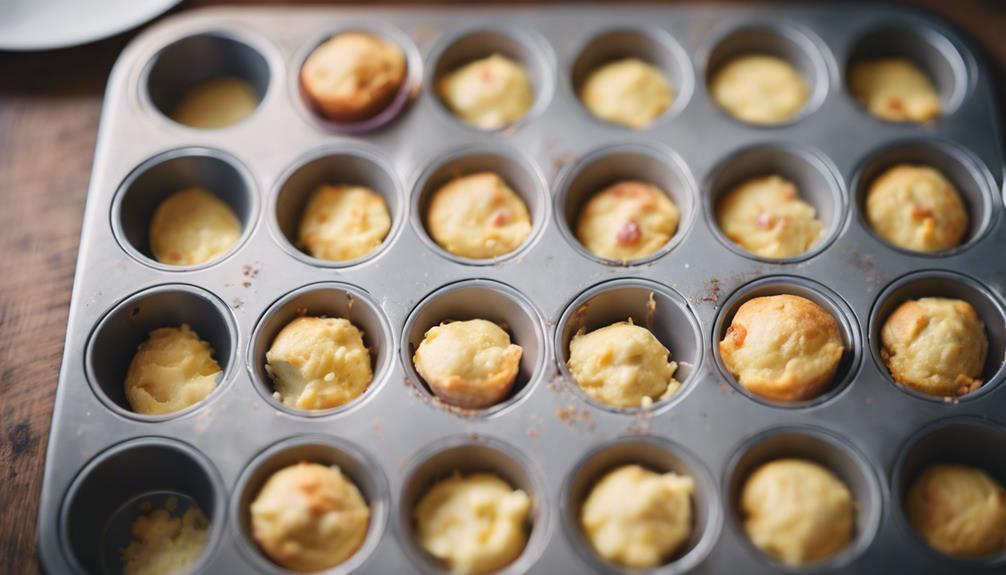
For best baking results, preheat your oven to 180C or 350F.
When making these delightful ham and cheese muffins, consider using a muffin tin lined with silicone muffin cases for easy removal and quick cleanup.
After baking, allow the muffins to cool on a wire rack; this simple step helps prevent sogginess and guarantees a perfect texture.
If you're feeling adventurous, try incorporating extra veggies like spinach or zucchini into the mix for a boost of nutrition that even the pickiest eaters won't notice.
Suppose you or your little one have dietary restrictions. In that case, fear not! You can easily adapt this recipe by swapping out dairy ingredients for non-dairy alternatives without compromising on flavor.
Ingredients and Substitutions

Consider exploring various ingredient substitutions to cater to different dietary preferences and restrictions when preparing these ham and cheese muffins for babies and toddlers.
Here are some creative swaps you can try:
- Cheese Substitutes: Experiment with dairy-free alternatives like vegan cheese or nutritional yeast for a lactose-intolerant option.
- Egg Replacements: If you're looking to avoid eggs, consider using mashed bananas, tofu, or ground flaxseeds to maintain the muffins' texture and moisture.
- Spinach Addition: Amp up the nutritional value by adding finely chopped spinach to sneak in some extra greens for your little ones.
- Customization Options: Feel free to tailor the recipe to suit specific tastes and dietary needs, ensuring that everyone can enjoy these savory treats guilt-free.
Nutritional Information
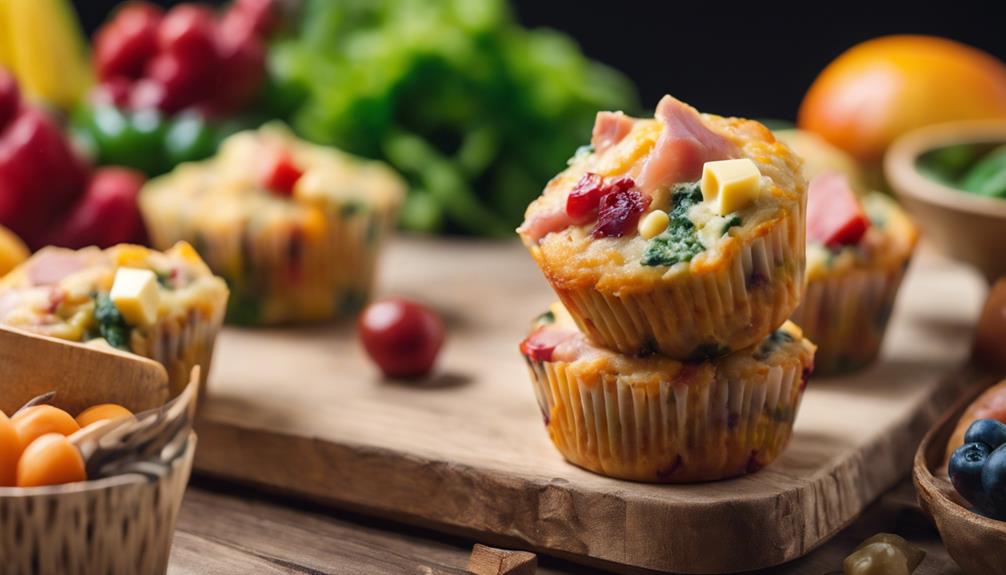
The nutritional content of these ham and cheese muffins is essential for supporting the growth and development of babies and toddlers. Cheddar cheese, a key ingredient, provides calcium and protein vital for bone health and growth in little ones.
Meanwhile, ham offers essential iron and vitamins necessary for healthy blood and brain development in growing children. If you decide to sneak in some spinach, you'll be adding extra iron and vitamins that contribute to overall health and immunity.
The flour in these muffins serves as a source of carbohydrates, giving your active little munchkins the energy they need throughout the day. When all these ingredients come together, they create a balanced snack option rich in essential nutrients tailored specifically for those tiny, growing bodies.
Storage and Equipment

Properly storing and having the right equipment are key to maintaining the freshness and quality of your ham and cheese muffins. To guarantee your savory snacks stay delicious, here are some handy storage tips and essential equipment recommendations:
- Fridge Storage: Store your cheese and ham muffins in the fridge for up to 5 days. Use an airtight container to keep them fresh and tasty.
- Freezer Storage: If you want to keep your muffins for longer, freeze them for up to 3 months in airtight containers or freezer bags. Make sure to label them with the date for easy tracking.
- Defrosting: When ready to enjoy your frozen muffins, defrost them in the fridge overnight. This gradual thawing process helps maintain their texture and flavor.
- Essential Equipment: Make sure you have a muffin tray, silicone muffin cups, airtight containers, and a mixing bowl. These tools will make baking and storing your ham and cheese muffins a breeze.
Baby and Toddler Food Recommendations

For babies and toddlers, introducing a variety of nutritious and age-appropriate foods is essential for their growth and development. When it comes to offering new foods like ham, it's crucial to do so gradually and select low-salt options to safeguard their health. You can start serving shop-bought ham to babies around 12 months of age, ensuring it's cooked until tender and cut into small, bite-sized pieces for safe consumption. Remember to keep an eye out for any allergic reactions when introducing ham or any other new foods to your little ones. Consulting with a health visitor or healthcare professional before introducing unfamiliar foods can help ensure both safety and optimal nutrition for your child.
| Baby Food Recommendations | Age to Introduce |
|---|---|
| Low-salt ham | 12 months |
| Small, bite-sized pieces | From the start |
| Allergic reaction monitoring | Always |
| Professional consultation | Before introducing |
| Variety of age-appropriate foods | Essential |
Frequently Asked Questions
How Do You Serve Muffins to Babies?
To serve muffins to babies, cut them into small, bite-sized pieces to prevent choking hazards. Offer as finger food for fine motor skills practice. Introduce gradually, watching for allergies. Make sure muffins are soft and easily chewable for developing eaters.
Are Muffins Healthy for Babies?
Muffins can be healthy for babies when made with nutritious ingredients. Consider portion size and overall nutritional value. Limit added sugars, salt, and unhealthy fats. Introduce gradually to watch for allergies. Consult experts for personalized advice.
Conclusion
So there you have it – delicious ham and cheese muffins that are perfect for your little ones! Remember, the proof is in the pudding, or in this case, the muffin.
Give these savory snacks a try and watch your baby or toddler gobble them up with delight. With the perfect balance of flavors and nutrients, these muffins are sure to be a hit at snack time.
Happy baking!
Recipes
Dream of Eating Groundnut? What It Means for You!
Open the door to unlocking hidden meanings behind your dreams of eating groundnuts and discover how they can shape your well-being and growth!

Dreaming of eating groundnuts? Your subconscious might be nudging you towards prioritizing health, growth, and well-being in your life. These dream symbols could symbolize vitality and inner abundance. Positive aspects include joy and upcoming victories, while encountering rotten peanuts indicates potential dissatisfaction. Dream analysis offers valuable insights into desires and promotes personal growth. By understanding these messages, you can reveal hidden truths and empower personal development. So, next time you dream of munching on groundnuts, pay attention—your dreams may hold the keys to a healthier, fulfilling life!
Key Takeaways
- Symbolizes desire for health, growth, and wellness.
- Indicates need for balanced and healthy lifestyle.
- May hint at potential decline in health luck.
- Prepares for potential relationship challenges.
- Offers insights into personal growth and well-being.
Symbolism of Eating Ground Nuts
When dreaming of eating ground nuts, the symbolism often signifies a deep-rooted desire for health, growth, and overall wellness in your life. Your subconscious is highlighting the importance of prioritizing your well-being and nurturing your physical and mental health. It serves as a gentle nudge to pay attention to your body's needs and aim for a balanced and healthy lifestyle. So, next time you dream of indulging in these crunchy treats, consider how you can incorporate more nutritious foods and self-care practices into your daily routine.
Furthermore, the act of consuming roasted peanuts slowly in your dreams may hint at a potential decline in your health luck, reminding you to take proactive steps to safeguard your well-being.
Dreaming of eating dry peanuts could be your mind's way of preparing you for upcoming relationship challenges or obstacles on the horizon. Remember, dreams about collecting scattered ground nuts suggest a promising outlook for your health and overall abundance. Embrace the symbolism, and let it guide you towards a path of vitality and wellness.
Psychological Analysis of Dream Symbols

In delving into the psychological analysis of dream symbols, one can uncover profound insights into the subconscious mind's workings and the hidden meanings behind various dream elements.
Dreams of eating groundnuts, according to Compensation Theory, might indicate a deep-seated longing for recovery and revitalization. Teleology suggests that such dreams could be sending you messages about taking proactive steps towards your future. Archetypes reveal that groundnuts symbolize vitality, health, and growth in the dream domain.
If you find yourself collecting groundnuts in a dream, it may signify a subconscious desire for inner abundance and well-being. These unconscious messages involving groundnuts could be nudging you towards actions that lead to a healthier and more fulfilling life.
Positive and Negative Aspects

In conclusion, the dream of eating groundnuts reveals both positive and negative aspects that can offer valuable insights into your subconscious mind's messages. Dreaming of munching on groundnuts signifies joy, pleasure, and upcoming victories in your life. It's like a sneak peek into the happiness and success waiting for you around the corner.
On the flip side, encountering rotten peanuts in your dreams might indicate looming dissatisfaction or potential disappointment on the horizon. It's like a gentle reminder to stay vigilant and address any areas of concern before they escalate.
If you find yourself shelling groundnuts while dreaming, it could be your subconscious nudging you towards becoming more open and transparent in your relationships. However, spotting rotten peanuts in your dream serves as a cautionary sign of decay or negative changes heading your way.
Additionally, the act of buying peanuts in a dream often symbolizes the fulfillment of your needs and desires. So, pay attention to these dream details; they might hold the key to understanding your inner thoughts and emotions.
Importance of Dream Analysis

Understanding the importance of dream analysis can provide valuable insights into your subconscious mind's messages. Dream symbols, like eating groundnuts, hold significance that can unlock hidden meanings within your psyche. By paying attention to your dreams and delving into their analysis, you can unravel the mysteries of your innermost desires and needs. This self-reflection not only aids in personal growth but also promotes overall well-being. Through dream analysis, you can start recognizing patterns in your thoughts and emotions, gaining a deeper understanding of yourself.
| Importance of Dream Analysis | |
|---|---|
| Insights into Subconscious | Recognition of Patterns |
| Symbolic Meanings | Personal Growth |
| Self-Reflection | Well-being |
| Understanding Desires | Emotional Awareness |
| Promoting Self-awareness | Psychological Development |
Self-Understanding Through Dream Interpretation

Beginning the exploration of self-understanding through dream interpretation enables you to delve into the depths of your subconscious mind and uncover hidden truths about yourself.
Dreams of eating groundnuts hold symbolic meanings that can reveal your desires for health, growth, and wellness in various aspects of your life. By analyzing these dreams, you gain valuable insights into your mental, emotional, and physical needs, fostering a deeper understanding of yourself.
Paying attention to dream symbols, such as groundnuts, allows you to recognize your innermost desires and aspirations that mightn't be consciously acknowledged.
Dream interpretation serves as a powerful tool for personal growth, as it reveals hidden messages and provides guidance towards overall well-being. Understanding the significance of eating groundnuts in your dreams empowers you to navigate through your subconscious thoughts and emotions with clarity.
Embrace this journey of self-discovery through dream analysis, and discover the potential for profound self-understanding and growth.
Frequently Asked Questions
What Is the Meaning of Eating Groundnuts in Dreams?
When you dream of eating groundnuts, it symbolizes a subconscious desire for health and well-being. Tasting roasted peanuts slowly may indicate a potential decline in health luck, while collecting scattered groundnuts signifies improving health and abundance.
What Is the Spiritual Power of Groundnut?
Groundnut's spiritual power lies in grounding energy, nurturing the soul, and symbolizing abundance. It offers stability and nourishment, reminding you to seek spiritual growth, inner strength, and balance in life to embrace the universe's abundance.
What Does It Mean When You Dream About Eating Nuts?
When you dream about eating nuts, it signifies desires for health, growth, or satisfaction. The act symbolizes pleasure, anticipation, or intimacy. Different forms may represent aspects of health or relationships. Details reveal insights into well-being and desires.
What Do Peanuts Represent in Dreams?
Peanuts in dreams symbolize desires for health, growth, and wellness. Eating groundnuts may represent anticipation of relationship issues or sexual desires. They reflect feelings about physical health, nutritional status, and well-being, signifying improving health and abundance.
Conclusion
So, next time you dream of munching on groundnuts, remember that it might symbolize your desire for nourishment and security. Dive deeper into the meaning behind this dream to uncover hidden emotions and thoughts that could be guiding you in your waking life.
Dream analysis may seem like a quirky hobby, but it can offer valuable insights into your subconscious mind. Who knew a simple snack could reveal so much about your inner world?
Keep dreaming, keep exploring, and keep snacking!
Recipes
Date Paste Recipe: Natural Sweetener for Baby Foods!
Find out how to make a natural sweetener for baby foods with this easy date paste recipe – a healthy and delicious alternative to refined sugar!

Looking to sweeten your baby's food naturally? Whip up some date paste for a healthy and delicious touch! Soak soft dates in hot water, blend with water for a smooth paste, and store in the fridge. Start with 1-2 teaspoons for babies, adjusting gradually. Beyond baby food, use date paste in baking, as a glaze, or in dressings. Blend pitted dates with hot water, adjusting for consistency. Engage with the community for tips and flavor enhancements. For a versatile and refined-sugar-free option, try date paste over syrup. Sweeten up your baby's meals with this tasty alternative!
Key Takeaways
- Soak Medjool dates in hot water for rich sweetness.
- Blend soaked dates with water for smooth paste texture.
- Start babies with 1-2 teaspoons, gradually increasing.
- Use date paste as natural sweetener in baby foods.
- Label and store date paste in airtight container in fridge.
Preparation Tips for Date Paste
Soaking your soft dates in hot water is an essential step in preparing Date Paste. Opt for Medjool dates for a rich, caramel-like sweetness. The soaking time can vary based on the type of dates you have. Whether it's an overnight soak or just 10 minutes in warm water, the goal is to soften the dates for blending.
Once soaked, toss them into a blender with water to create a smooth Date Paste. For larger batches, start with 1 cup of dates, adjusting the water to achieve your desired consistency. This natural sweetener not only adds a lovely flavor to your baby foods but also provides essential nutrients.
When it comes to storage, keep your Date Paste fresh by refrigerating it for a couple of weeks. If you've made a big batch, Date Paste freezes beautifully for up to 6 months. Get ready to sweeten those baby foods with this delicious and nutritious paste!
Storage Guidelines for Date Paste
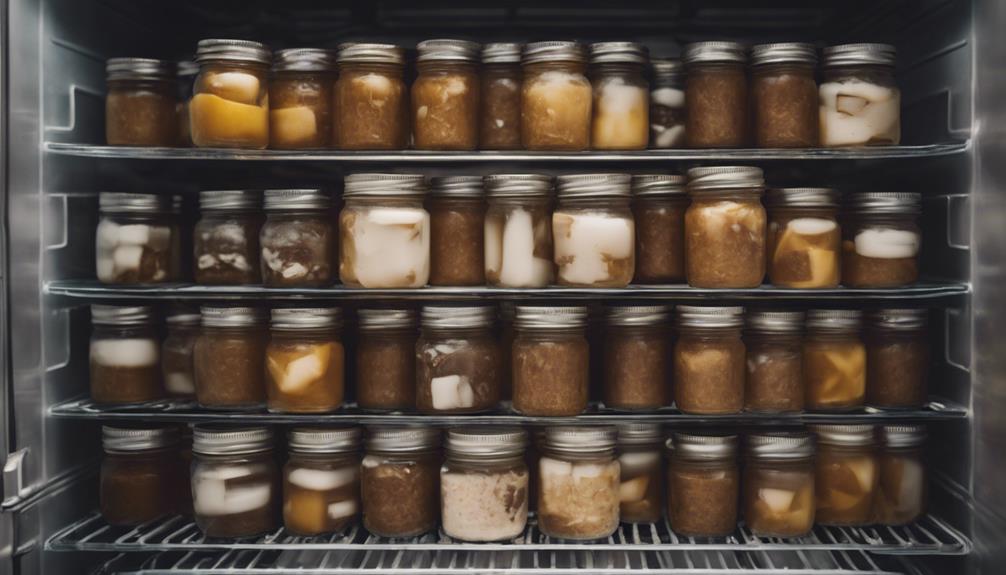
Consider storing your date paste in the refrigerator for several weeks in an airtight container to maintain its freshness and quality. For longer-term storage, freezing date paste for up to 6 months is also an option.
Here are some guidelines to guarantee your date paste stays fresh and safe for consumption:
- Use an airtight container: Seal your date paste in a container to prevent air exposure, which can lead to spoilage.
- Label with preparation date: Keeping track of when you made the date paste helps you know its freshness and usage timeline.
- Check for spoilage: Before using stored date paste, inspect for any signs of spoilage such as mold, off-smell, or unusual texture to ensure safety.
Date Paste Quantity for Babies
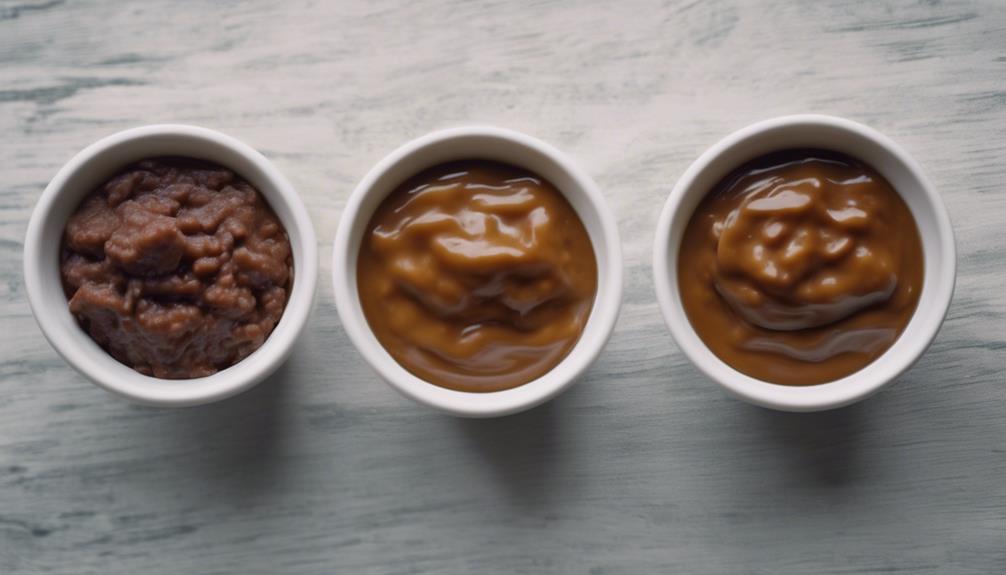
When feeding your little one date paste, remember to start small with just 1-2 teaspoons to gauge their reaction.
Slowly increase the quantity as they grow and develop a taste for it.
It's all about age-appropriate portion control to make sure they enjoy the benefits without overdoing it!
Serving Size for Babies
For babies, determining the appropriate serving size of date paste starts with introducing 1-2 teaspoons initially. Date paste can be a delightful natural sweetener to enhance the flavor and nutritional value of baby foods.
Here are some tips to help you navigate serving sizes for your little one:
- Start small: Begin with a conservative amount of 1-2 teaspoons to gauge your baby's tolerance and enjoyment of date paste.
- Gradual increase: As your baby grows and becomes accustomed to the taste and texture, you can gradually increase the quantity in their meals.
- Three-day rule: Remember to follow the three-day guideline when introducing date paste or any new food to make sure your baby doesn't have any allergic reactions.
Age-Appropriate Portion Control
Guarantee your baby's portion sizes of date paste align with their age and dietary needs by starting with 1-2 teaspoons as a guideline. When introducing date paste into your baby's diet, it's important to begin with a small amount to assess their tolerance and avoid any potential digestive issues.
Gradually increasing the quantity as your baby grows and shows no signs of intolerance is the best approach. Remember to follow the three-day rule when introducing new foods to watch out for any allergic reactions.
Date paste not only serves as a natural sweetener for baby foods but also enhances their flavor profile and boosts the nutritional value of the meals. While date paste is safe for babies when consumed in moderation, it's crucial to maintain portion control to ensure your little one receives a balanced diet.
Keep an eye on how your baby responds to date paste and adjust the portion sizes accordingly to support their healthy growth and development.
Alternate Uses of Date Paste

Looking to jazz up your recipes with a natural twist?
Date paste is your go-to ingredient!
From sweetening your morning pancakes to enhancing the flavor of your favorite desserts, date paste offers a versatile and healthy alternative to traditional sweeteners.
Get ready to elevate your cooking game with this simple yet impactful ingredient!
Recipe Versatility
Explore the various ways date paste can be creatively incorporated into different recipes to introduce natural sweetness and essential nutrients to your baby's diet.
Date paste isn't only a great sweetener for baby foods, but it can also be used in various other recipes to enhance flavors and provide healthy alternatives. Here are some exciting ways to utilize date paste:
- Spread it on dosas, pancakes, Chapati/roti, or bread for a natural sweet touch that toddlers and babies will love.
- Replace sugar in baking cakes, muffins, and cookies with date paste to create healthier snacks for your little ones.
- Elevate desserts like puddings, custards, and fruit salads by adding date paste for a mild, caramel-like sweetness while boosting the nutritional value of the treats.
Incorporating date paste into your recipes not only adds sweetness but also introduces fiber and essential nutrients to your baby's diet in a delicious way.
Sweetening Options
To diversify your baby's diet, consider incorporating date paste as a versatile sweetening option in various recipes beyond traditional baby foods. Date paste serves as a natural sweetener, offering a healthier choice compared to refined sugars. This versatile ingredient can enhance the flavor of purees, porridges, and other baby food recipes while ensuring optimal nutrition for your little one. Not only can date paste be used in baby foods, but it also makes a delicious spread for dosas, pancakes, Chapati/roti, or bread, adding a touch of sweetness to meals for both babies and toddlers. Additionally, you can substitute date paste for sugar in baking cakes and desserts for babies, introducing a natural and nutritious sweetness. By incorporating date paste into your baby's meals, you're not only providing a sweet flavor but also essential nutrients like fiber, iron, calcium, and potassium, promoting your child's overall health and well-being.
| Sweetening Option | Description | Usage |
|---|---|---|
| Date Paste Spread | A natural sweetener rich in essential nutrients | Spread on dosas, pancakes, Chapati/roti, or bread |
| Baking Substitute | Healthy alternative to refined sugars | Use in baking cakes and desserts for babies |
| Flavor Enhancer | Enhances taste without compromising on nutrition | Mix into purees and porridges for added sweetness |
| Nutrient Booster | Adds fiber, iron, calcium, and potassium | Incorporate into various baby food recipes |
Cooking Enhancements
Consider incorporating date paste into your cooking repertoire to elevate the flavors and nutritional value of your dishes. This versatile ingredient can be used beyond sweetening baby foods.
Here are some cooking enhancements you can explore with date paste:
- Use date paste to glaze roasted vegetables for a caramelized sweetness.
- Mix date paste into marinades for meats to add depth of flavor.
- Stir date paste into salad dressings for a hint of natural sweetness and richness.
Date Paste Recipe Details
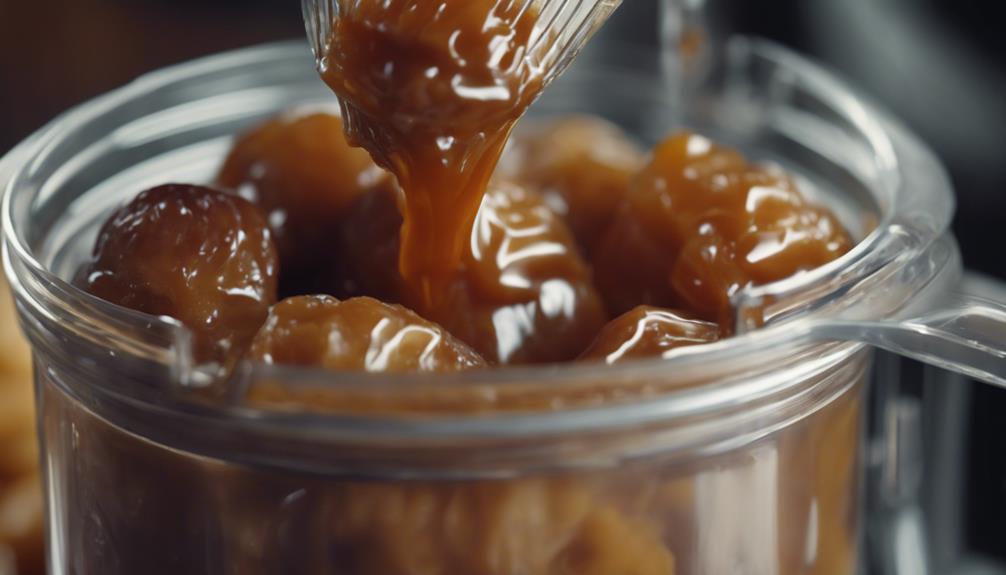
To guarantee the quality of your date paste, start by soaking whole or pitted dates in hot water to soften them before blending into a smooth puree. Make sure that your dates are free of pits to avoid damaging your blender. Use a powerful blender to achieve a silky texture that works well in various recipes.
Once blended, transfer the date paste into an airtight container for storage. When storing, refrigerate the paste for up to three months. If you want to keep it longer, consider freezing it for extended use.
Remember to check the consistency of your date paste before storing it. If it's too thick, you can add a bit of water and blend again until you reach the desired texture. Date paste is a versatile sweetener that can be used in a wide range of dishes, making it a handy ingredient to have on hand.
Now that you know the details of creating and storing date paste, you're ready to add this natural sweetener to your baby food recipes!
Feedback and Adjustments for Recipe

You may want to adjust the amount of hot water used in the recipe based on user feedback for best results.
Incorporating user feedback is crucial to enhancing the recipe for date paste. Here are some adjustments to contemplate based on user feedback:
- Opt for a gradual approach: Try adding the hot water gradually while blending the dates to achieve the desired consistency.
- Experiment with different ratios: Test varying amounts of hot water to find the perfect balance that suits your preference.
- Seek input from the community: Engage with other users to gather additional insights and tips for improving the recipe.
Date Paste Query: Paste Vs. Syrup
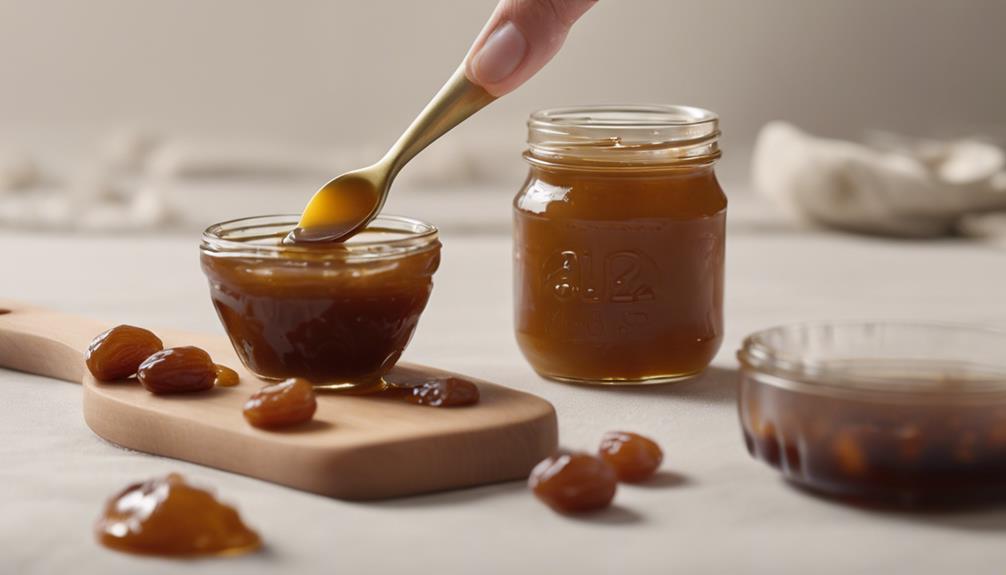
When deciding between date paste and syrup for baby foods, consider the different textures and applications each offers. Date paste serves as a natural sweetener, providing a healthy alternative to refined sugars. It boasts a thick, spreadable consistency, ideal for incorporating into various baby food recipes.
On the other hand, date syrup presents itself as a liquid sweetener, offering versatility in different culinary creations. If you prefer a pourable texture, you can easily convert date paste into a syrup by simmering it with water.
Both date paste and syrup can enhance the flavor of dishes without the need for refined sugars, making them excellent options for baby foods and beyond. Understanding the distinctions between the two allows you to experiment and find the perfect fit for your recipes.
Frequently Asked Questions
Can You Use Dates to Sweeten Baby Food?
You can use dates to sweeten baby food. Start with small amounts and increase gradually based on your baby's taste. Date paste is a healthy alternative to refined sugars, enhancing flavor and nutrition in baby purees, porridges, and snacks.
How Do You Use Dates as a Natural Sweetener?
To use dates as a natural sweetener, blend pitted dates with water to make date paste. Add this paste to baby porridges or purees for a sweet, nutrient-rich boost. Dates offer a healthy alternative to refined sugars in baby foods.
Can Babies Eat Date Paste?
Yes, babies can eat date paste. Start with small amounts, gradually increasing as they grow. Follow the three-day rule when introducing new foods like date paste to watch for allergies. It's a natural sweetener for baby foods!
How to Use Date Paste Instead of Sugar?
To use date paste instead of sugar, simply swap it in a 1:1 ratio in your baby food recipes. Enhance nutrition and sweetness effortlessly. Incorporate date paste into purees and porridges for a healthier alternative that provides essential nutrients.
Conclusion
So, there you have it – date paste isn't only a natural sweetener for baby foods, but it's also versatile and easy to make at home.
With the right preparation tips, storage guidelines, and quantity adjustments for babies, you can enjoy the benefits of this healthy alternative to refined sugars.
So go ahead, get creative in the kitchen and whip up a batch of date paste to sweeten up your little one's meals!
Recipes
Beet Puree for Baby: Nutritious and Vibrant First Food!
Boldly introduce your baby to the vibrant world of homemade beet puree, a nutritious and colorful first food that will nourish their taste buds and health!

Ready to explore the world of homemade baby food with beet puree? It's a vibrant and nutritious first food choice that will jazz up your baby's meals! Packed with essential vitamins and fiber for digestion, it's a colorful addition to your little one's diet. Simply roast, peel, and blend beets with fruits or veggies for extra flavor. Store in the fridge for a week or freeze in ice cube trays. Spice it up with cinnamon or ginger for added zest! Immerse yourself in the realm of homemade baby food with beet puree—it's a tasty, healthy treat that your little munchkin will love! Discover more beet-licious tips and tricks for your baby's meals.
Key Takeaways
- Nutrient-rich puree supports growth and immunity.
- Mix with fruits and veggies for variety.
- Provides essential fiber for digestion.
- Vibrant color adds mealtime excitement.
- Easy storage in fridge or freezer for convenience.
Why Choose Beet Puree for Babies
When introducing solid foods to your baby, opting for beet puree can be a nutritious and flavorful choice. Beets are nutrient-rich, packed with essential vitamins and minerals like calcium, folate, and Vitamin C, providing a wholesome start to your little one's culinary journey.
The versatility of beets allows you to mix them with other purees, introducing diverse flavors to your baby's palate early on.
Not only are beets delicious, but they also offer a healthy dose of fiber, which is important for aiding digestion and preventing constipation in infants. This makes beet puree a wise choice for supporting your baby's tummy health as they start solid foods.
Additionally, the immune-boosting properties of beets contribute to your baby's overall well-being, while the nutrients in beet puree support their growth and development.
In essence, beet puree isn't just a first food; it's a powerhouse of nutrition that can benefit your baby's health in multiple ways.
The Ingredients and Preparation
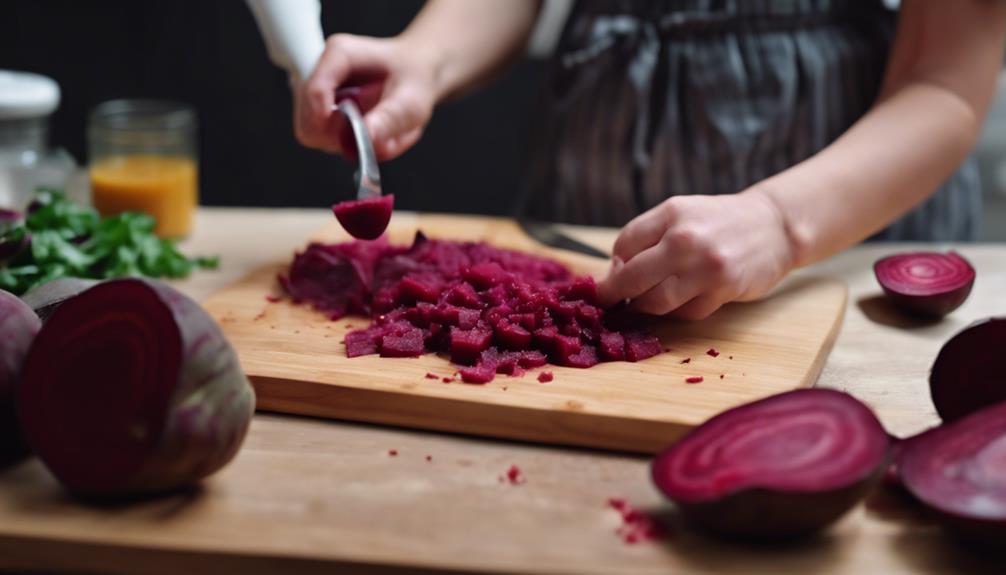
To create beet puree for your baby, start by roasting the beets until tender, then peel and puree them in a food processor. Beets are packed with essential nutrients like calcium, folate, and Vitamin C, making them an excellent choice for your little one's diet. Mixing beet puree with fruits such as applesauce or vegetables like butternut squash can introduce exciting flavors and variety to your baby's meals. When preparing beet puree, consider storing it in the fridge for up to 5 days for convenience or freeze it in ice cube trays for longer preservation.
| Ingredients | Preparation | Benefits |
|---|---|---|
| Beets | Roast until tender | Rich in nutrients |
| Food Processor | Peel and puree | High in Vitamin C |
| Ice Cube Trays | Store or freeze | Adds flavor variety |
Including beets in your baby's diet not only adds vibrant color but also contributes to their growth and immune support. Experiment with different combinations to find the perfect mix that your baby will love.
Making Beet Puree at Home

For a nutrient-rich and colorful addition to your baby's diet, consider making beet puree at home. Beets are packed with essential vitamins and minerals, making them an excellent choice for your little one's first food.
To make beet puree, start by roasting the beets in the oven until they're tender. Once cooked, peel the beets and blend them into a smooth puree using a food processor. You can get creative by mixing beet puree with other fruits and vegetables like applesauce, butternut squash, or broccoli to introduce different flavors and provide variety in your baby's meals.
When it comes to storage, store the beet puree in airtight containers in the fridge for up to 5 days. If you want to keep it longer, freeze the puree in ice cube trays for convenient portioning.
This homemade beet puree not only offers a burst of color and flavor but also delivers essential nutrients vital for your baby's growth, digestion, and immune system support. Get ready to introduce your little one to a vibrant world of nutritious goodness!
Tips and Serving Suggestions
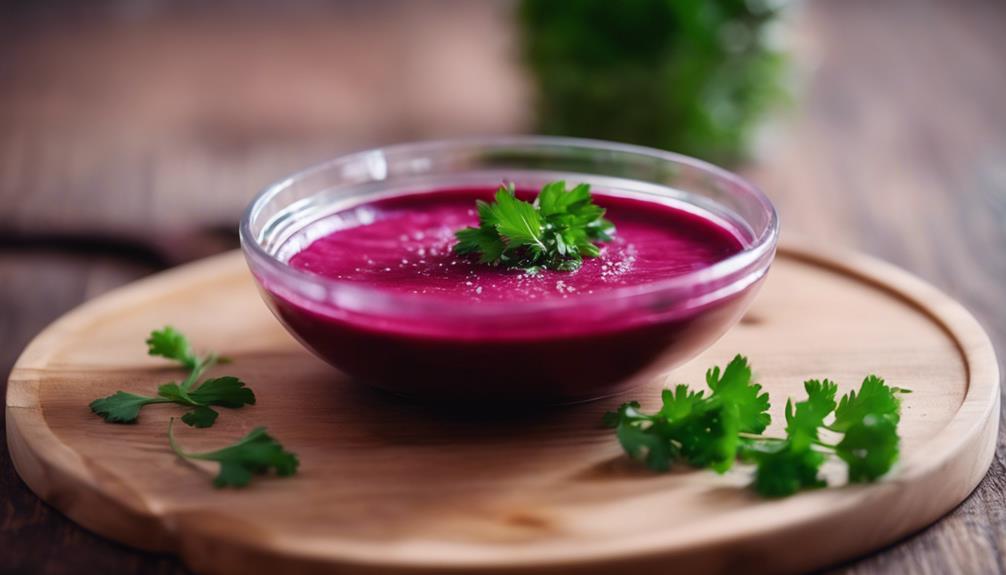
Consider enhancing your baby's beet puree by incorporating a variety of fruits and vegetables to introduce diverse flavors and textures. Mixing in ingredients like applesauce or butternut squash can not only add a twist to the taste but also provide additional nutrients for your little one's growth and development. Below are some creative serving suggestions to make mealtime enjoyable for your baby:
| Fruit Combos | Vegetable Additions | Spices |
|---|---|---|
| Pear | Sweet Potato | Cinnamon |
| Blueberries | Carrots | Ginger |
| Banana | Spinach | Nutmeg |
| Avocado | Zucchini | Cardamom |
Storage and Freezing Instructions
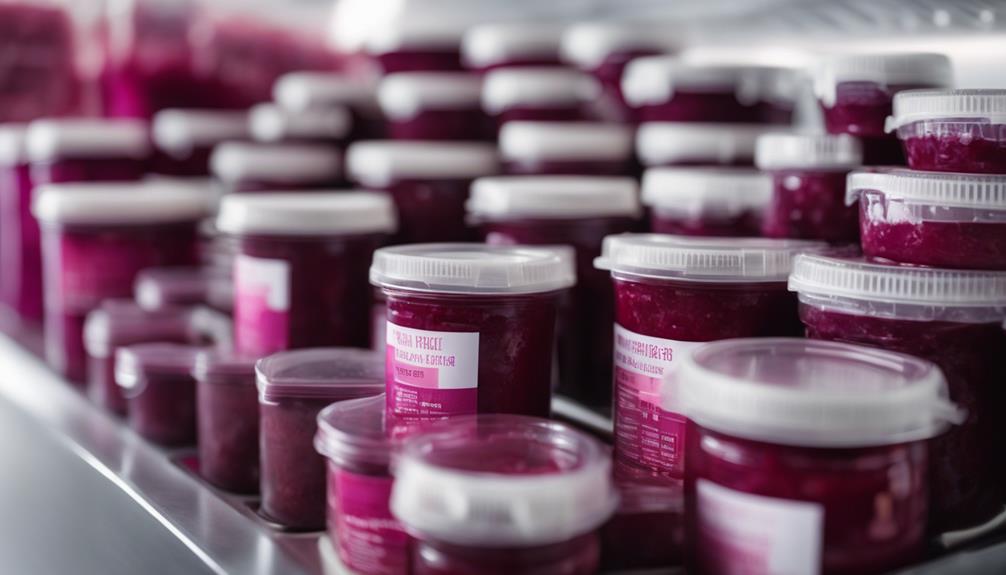
For best freshness, store beet puree in airtight containers in the fridge for up to 5 days.
When it comes to freezing, consider using ice cube trays for convenient portioning and storage lasting up to 3 months.
Thaw your frozen beet puree in the refrigerator or at room temperature before serving it to your little one.
To keep things organized, opt for labeled freezer bags to easily track when the puree was made.
Remember to cut your beets into similar-sized pieces before cooking and blending for a smoother puree texture.
- Airtight containers in the fridge help maintain the vibrant color and nutrients.
- Ice cube trays make it simple to grab just the right amount when needed.
- Thawing in the refrigerator preserves the puree's texture and flavor.
- Labeled freezer bags prevent confusion and help you stay organized.
- Cutting beets into similar-sized pieces ensures even cooking and blending for a perfect consistency.
Frequently Asked Questions
Are Beets a Good First Baby Food?
Yes, beets are a fantastic first baby food choice! They offer a range of essential nutrients, support healthy digestion, and have a naturally sweet taste that babies love. You can easily mix beets with other purees for added nutrition.
How to Puree Beets for Babies?
To puree beets for babies, roast, peel, and blend them until smooth. Make sure they're cooked soft to avoid choking hazards. Mix with other fruits/veggies for tasty combos. Store and freeze for easy meals.
What Are the Benefits of Beetroot Puree?
Beetroot puree offers a wealth of benefits for your little one. Packed with essential nutrients, this vibrant puree aids digestion, supports immune health, and introduces delicious flavors. Easily made at home, it's a convenient choice for busy parents.
Is Raw Beetroot Safe for Babies?
You might wonder, is raw beetroot safe for babies? Yes, it is when prepared correctly. Grate or cook it until soft to avoid choking hazards. Introduce this vibrant veggie in ways that suit your little one's needs.
Conclusion
To sum up, beet puree is a nutritious and vibrant first food option for your little one. Packed with essential nutrients and easy to prepare, this colorful puree is sure to be a hit at mealtime.
So go ahead, whip up a batch of beet puree at home and watch as your baby enjoys every spoonful of this delicious and healthy treat!
Happy feeding!
-

 Activities and Learning4 months ago
Activities and Learning4 months agoEngage Quiet Students With Interactive Quiz Apps
-

 Vetted4 months ago
Vetted4 months ago9 Best Personalized Father's Day Gifts for Your Husband – Thoughtful and Unique Ideas
-

 Activities and Learning4 months ago
Activities and Learning4 months agoAvelox: A Prescription-Free Risk
-

 Activities and Learning4 months ago
Activities and Learning4 months agoActive Forum Requires User Interaction for Access
-

 General Tips4 months ago
General Tips4 months agoStruggling Mom Quotes: Words of Hope and Encouragement!
-

 Activities and Learning4 months ago
Activities and Learning4 months agoRobaxin: CVS Orders, Renal Health Caution
-

 Activities and Learning4 months ago
Activities and Learning4 months agoGet Levaquin: Treat Infections & Stay Safe
-

 Activities and Learning4 months ago
Activities and Learning4 months agoCabaser: Risks, Alternatives, and Gambling Concerns




































